INTRODUCTIONDizziness and body instability are symptoms caused by body balance that arise from vestibular, visual and proprioceptive information disorder. Vestibular disfunction in children usually affects communicative skill, psychological condition and academic performance (1).
Labyrinth diseases in children are hardly ever rare. Its diagnosis is difficult because of the amount of different symptoms. Many times children do not recognize dizziness as an "abnormal" symptom and can not describe it. In most of cases they refer symptoms as pain and hysteria.
Vertigo in children is a very interesting issue because it involves important pathologies, thus, if precociously diagnosed they can be treated in a proper way avoiding possible repercussions on motor and cognitive development (2).
In this way, when a minor suspicious of vestibular occurrence, child must have an otoneurological examination in order to establish a correct diagnosis and then be led to a suitable treatment (3).
Ganança and Ganança (3), describe that cerumem or foreign bodies cause partial or total nasal obstruction of the external acoustic meatus causing then dizziness and associated symptoms, by sensorial disturb due to pressure on tympanic membrane.Acute otitis media can reach internal ear causing severe supurative labyrinthitis and also it can damage hearing and vestibular functions, meningitis and other infection on Central Nervous System.
Benign Paroxysmal Vertigo is more frequent in children aging 2 and 6 years, and more rarely in healthy children up to 12.
Kinetosis is the state of being dizzy or nauseated, followed sometimes by vomiting, paleness and cold sudoresis in children because of the motions that occur while traveling in or on a moving vehicle such as cars, boats, planes etc., or even in thrilling rides and others (3).
Migraine caused by vestibular symptom is a hereditary disorder that disturbs cerebral circulation in the vertebrobasilar arterial complex, present especially in migraine crisis breaks (4).
Ototoxics are drugs such as antibiotics, diuretics, quinine-based antiinflamatories and home insecticide affecting cochleovestibular in a toxic way, causing dizziness, nausea, vomiting, hearing failures what can sometimes be severe and irreversible and tinnitus, because they damage internal ear.
Different metabolic disturbance can cause vestibular symptoms in children such as: hyperglycemia, hypoglycemia, hyper-insulism, insulinopenia, bad absorption in the intestinal tract, severe anemia, adrenocortical insufficiency, hypothyroidism, obesity, etc. (3).
A child will hardly complain of dizziness, though labyrinth diseases affect both children and adults with different antecedents and signs from those found in adults, so differential diagnosis of balance disorder is essential during this age (5).
Soares and col. (6), resarching vertigo in children, observed that headache was the main symptom between the ages six and twelve, usually associated to vertigo and nausea.
Children can hardly describe or remember symptoms, and when they discomfort arises they cry and search for mother´s support. Those symptoms are usually misunderstood as a simple discomfort followed by nausea, and often mistaken as headache or faint feeling, epilepsy, gastrointestinal discomfort, etc. (1).
In many cases, children can present balance alterations with falls and collisions, having difficulties when playing, bicycle-riding, walking over walls, rope-jumping and going into thrilling rides (5).
Formigoni (5) pointed that young children with vestibular alterations are often unquiet due to the search for a comfortable and safe position, affecting academic concentration.
According to Ganança and Ganança (3), we should take into consideration unspecified complaints such as sudden behavior change, anxiety, sleep disorder, headache, fear of high and dark places, falls, psychological insecurity, delay of neuropsychomotor development, loss of conscience, nausea and vomiting, chronic physical incapacity, bad academic performance and language disorder.
Both children and adults suffer during manifestations and consequences from vestibular disorder in their everyday life, presenting cognitive problem and social isolation what influences their development directly and in a negative way (7).
That is why vestibular disorder deserves special attention and suitable treatment is essential in order to avoid irreversible alteration.
Lavinsk and col (2), described the great interest in the study of labyrinth function and vertigo in children due to a large occurrence of vestibular disorder in them, and its consequences can cause a series of repercussion as delay of motor and learning development, interfering on intellectual skill of the language, speech, reading and writing.
Soares and col (6) revised 37 records from children with complaints of vertigo or vestibular disorder. The result showed that vertigo or dizziness in 75% of the cases were the most frequent symptoms. Most of them was associated to other clinical manifestations such as neurovegetative symptoms (paleness, tachycardia and sudoresis) followed by nausea and/or vomiting in 56% of the cases. And third common complaint in 43% of the cases was headache together with or later vertigo, followed or not by other symptoms.
Caovilla (8), examined vestibular system in 84 normal children and concluded that there was no expressive difference between sex and age evaluated.
Vertigo in children is corresponds to 1% of the visits in neuropediatric ambulatory, and 13% of the children sent to audiological evaluation (3).
According to the authors mentioned, 1000 patients were submitted to computed otoneurological examination. It was noticed a prevalence of 2.4% of alteration on patients aging from 5 months to 12 years.
Identifying such diseases in children is difficult because complaints are inconsistent and unspecified. Because of that, new studies related to computed vectonystagmography were introduced in the clinical practice, enlarging diagnostic sensitiveness in otoneurology, obtaining more precise results with a more detailed analysis of the vestibular function and its consequences in delaying motor development and in language and speech acquisition.
Thus, it is necessary to know the normal functioning from vestibular system in children in order to identify possible labyrinth alterations. Therefore, this study had as a target to evaluate vestibular system in children without hearing and vestibular complaints through computed vectonystagmography examination.
MATERIAL AND METHOD
Type of studyThe experimental study was submmited and approved by Comitê de Ética em Pesquisa da Universidade Metodista de Piracicaba - UNIMEP (Ethics Committee in Research from Metodista University) number 21/04.
Selection of casesFrom the 29 children examined, 17 were male and 12 female aging from 10 to 12, without presenting any hearing and vestibular complaint, such as vertigo, vertigo and hearing loss. To select cases, it was performed such exams: anamnesis, meatuscopy, audiological exam and otoneurological evaluation.
Those subjects were invited to take place in the exam as volunteers, and the responsible person for the children signed a free and clear consent, assuring physical integrity of the children not exposing them to any risk factor and gravity of their general health.
PlaceThe current study was done at Clinic-School of the Phonoaudiology of Universidade Metodista de Piracicaba - UNIMEP. Audiometric and vestibular exams were performed in children who visited the clinic from August to Dezember 2004.
AnamneseisAt first, child was submitted to anamnesis at the presence of their parent/responsible, where information related to child´s complaints, related symptoms, previous diseases and personal habits history were collected.
Meatuscopy Meatuscopy was performed at Phonoaudiology Clinic of Unimesp with the purpose of dismissing any possibility of external ear disease such as presence of foreign body and cerumen, removing them. And for that we had the help from Dr. Pedro Henrique de Miranda Motta, ENT doctor in the mentioned university.
Audiological ExamIt was performed tonal audiometry by air pathway in the frequences of 0.25 kHz, 0.50 kHz, 1 kHz, 2 kHz, 3 kHz, 4 kHz, 6 kHz and 8 kHz and by bone pathway in 0.50 kHz, 1 kHz, 2 kHz, 3 kHz, 4 kHz, when necessary (9).
A research of the speech recognition percent rate and speech recognition threshold was done according to the referred criteria. It was used an audiometer MADSEN - MIDIMATE 602, calibrated according to standard ANSI S3. 6 (10).
It was also done impedanciometry with tympanometry tests and research of acoustic reflex in frequencies of 0.50k Hz, 1 kHz, 2 kHz, 3 kHz, 4 kHz, in ipslateral and contralateral way (9). It was used an impedanciometer INTERACOUSTICUS - AZ26, calibrated according to standard ANSI S3. 6 (10).
To make the required criteria assured it was done a biological calibration in order to observe any alterations on acoustic features of the gadget.
All audiometric exams were performed in an acoustically designed booth according to the standard ANSI S3.1 (11), in such a way that the level of sonorous pressure does not exceed the maximum levels allowed by international standard.
Vestibular Exame Parents, whose children would be examined, were advised to warn their children against any product containing caffeine, such as coffee, chocolate, sodas, tea and also to avoid any medication which could interfere on the exam result and keep fasting four hours before the exam (12).
The purpose of the vectonystagmography exam was to evaluate labyrinthic function through the following procedures: calibration of eye movement; spontaneous, semi-spontaneous and positional nystagmus; optokinetic, rotatory and air caloric tests. This examination was performed through electrodes placed close to the eyes, analyzing variation of cornea-retina potential during eye movement, which presents a quick stage and a slow one in opposite direction, where hystagmus could be observed. We can, through computed vectonystagmography exam, obtain a deeper and more precise study, which is able to analyze vestibular system in detail.
The equipment used to perform computed vectonystagmography exam belongs to Neurograff - Eletromedicina Ind. & Com. Ltda. It holds a specific software (Vec - Win), a luminous bar, where visual stimuli can be seen, an NGR05 air otothermometer for caloric test performance and a pendular chair (PPD-93 Yoshi).
Inclusion CriteriaChildren who took part of this research were from 10 to 12 years old and without hearing and/or vestibular compliant.
Exclusion CriteriaChildren under 10 and over 12 years old and with any previous hearing and/or vestibular compliant did not take part in the research.
Criteria for analysis Result evaluation of the vestibular exam followed the previously determined standards (13).
RESULTSThe results from the volunteers will be in relation to sex and vestibular alteration by relative and absolute values and in relation to frequent complaints because statistical analysis was not done, by the fact that this study is exploratory and descriptive.
Both Table 1 and Graph 1 display the distribution of the subjects in terms of sex and vestibular alteration. From the 29 subjects evaluated 17 were male and 12 female. From these 29, 14 boys (60.8%) and 7 (39.2%) girls presented normal vestibular exams; 2 boys (66.6%) and 1 girl (33.4) presented unilateral irritative peripheral vestibular syndrome; 1 boy (33.4%) and 2 girls presented (66.6%) bilateral irritative peripheral vestibular syndrome; It was not found any deficient and central results. And it is also possible to notice that 6 subjects examined (20.7%) presented vestibular alteration.

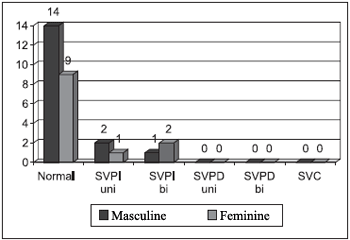
Graph 1. The individuals' distribution in function of the sex and vestibular alteration. Legend: Normal = university entrance exam normal; SVPI united = Syndrome outlying vestibular irritativa unilateral; SVPI bi = Syndrome outlying vestibular irritativa bilateral; SVPD united = outlying vestibular Syndrome deficient unilateral; SVPD bi = outlying vestibular Syndrome deficient bilateral; SVC = central vestibular Syndrome.
Both Table 2 and Graph 2 display the distribution of the subjects in terms of complaints. From the 29 subjects, 14 of them (48.2%) presented headache, 13 (44.8%) anxiety, 10 (34.4%) presented reading difficulty, 7 (24.1%) presented understanding difficulty, 11 (37.9%) presented concentration difficulty, 13 (44.8%) presented complaints of discomfort when playing in rotatory rides and 5 (17.2%) complained of tinnitus.
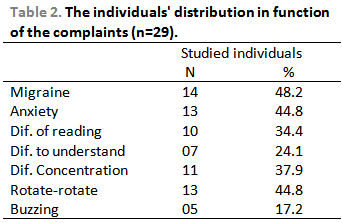
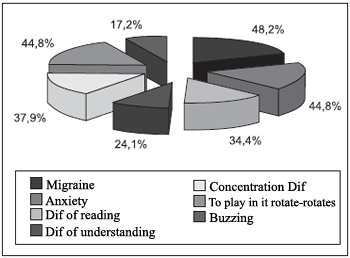
Graph 2. Distribution of the indivídulos in function of the complaint presented.
Both Table 3 and Graph 3 display the distribution of the subjects in terms of complaints such as: headache, anxiety, reading and understanding difficulty, summing up 29 subjects. From the 14 subjects who complained of headache, 11 of them (71.6%) presented normal vestibular exam; 2 (14.3%) presented unilateral irritative peripheral vestibular syndrome and 2 (14.3%) presented bilateral irritative peripheral vestibular syndrome. From 13 subjects who complained of anxiety, 12 (92.3%) presented normal vestibular exam and 1 (7.7%) bilateral irritative peripheral vestibular syndrome.
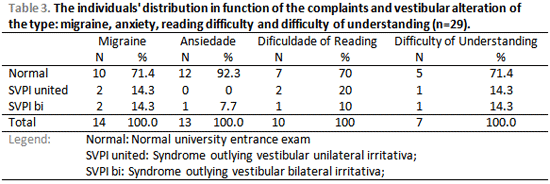
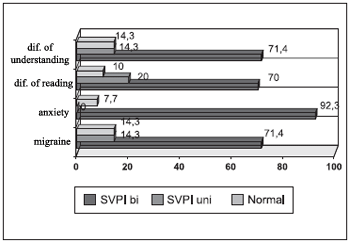
Graph 3. The individuals' distribution in function of the alteration college entrance exam and complaints of the type: migraine, anxiety, difficulty of reading and difficulty of understanding (n=29).
From the 10 subjects who complained of reading diffculty, 7 (70%) presented normal vestibular exam, 2 (20%) presented unilateral irritative peripheral vestibular syndrome and 1 (10%) presented bilateral irritative peripheral vestibular syndrome. From the 7 subjects who complained of understanding difficulty, 5 (71.4%) presented normal vestibular exam, 1 (14.3%) presented unilateral irritative peripheral vestibular syndrome and 1 (14.3%) presented bilateral irritative peripheral vestibular syndrome.
Both Table 4 and Graph 4 display the distribution of the 29 subjects in terms of complaints and vestibular alteration such as: playing in rotatory rides, tinnitus and concentration difficulty. From 13 subjects who complained of discomfort when playing in rotatory rides, 11 of them (84.6%) presented normal vestibular exam, 1 (7.7%) presented unilateral irritative peripheral vestibular syndrome and 1 (7.7%) bilateral irritative peripheral vestibular syndrome. From 5 subjects who complained of tinnitus, 4 of them (80%) presented normal vestibular exam, none presented unilateral irritative peripheral vestibular syndrome and only 1 (20%) bilateral irritative peripheral vestibular syndrome. From 11 subjects with concentration difficulty, 8 of them (72.7%) presented normal vestibular exam, 1 (9.1%) unilateral irritative peripheral vestibular syndrome and 2 (18.2%) presented bilateral irritative peripheral vestibular syndrome.

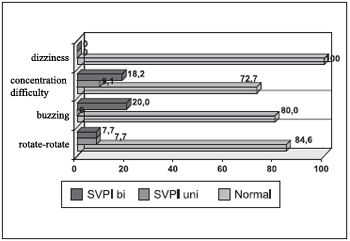
Graph 4. The individuals' distribution in function of the alteration college entrance exam and complaints of the type: to play in it rotate-rotates, buzzing and concentration difficulty and dizziness (n=29).
From the 29 subjects examined, 17 were male (58.6%) and 12 female (41.4%).
From the 17 male subjects examined, 14 of them (82.3%) presented normal vestibular exam. From the 12 female subjects, 9 of them (75%) did not present any alteration as well. We observed an agreement in a research by Caovila (8), where 84 normal children were examined and the conclusion is that there is no expressive difference between sex and ages examined.
In the current research, it was observed that 6 (20.6%) subjects presented unilateral and bilateral irritative vestibular alteration. Ganança and Ganança (3) assured that vestibular pathologies in children are not so rare and it is believed that vertigo in children represents 1% of the visits in neuropediatric ambulatory, and it can also represent 13% of the children sent to audiological evaluation.
It was observed that the subjects, who were examined, presented some vestibular complaint when questioned directly in the moment of anamnesis, although, children with no vestibular complaint had the preference. All this information makes us to agree with Ganança and Caovilla's (1). They say that many children present difficulties when describing what they feel or when remembering symptoms, and many times they misunderstood.
From the 29 subjects examined, 14 (48.3%) reported headache, and this complaint occurred in a large incidence, what agrees with Soares and col. (6), who researched children with vertigo complaint or vestibular alteration suspicion, found headache as the third more often complaint. They occurred together with or just after vertigo, followed or not by other symptoms. The subjects examined in the current research with headache, did not report vestibular alteration.
From the 13 subjects whit anxiety, 12 of them (92.3%) presented normal vestibular exam and one (7.7%) bilateral irritative peripheral vestibular syndrome We can, this way, observe that the high rate of anxiety did not present any relation with results of vestibular alteration. We believe that neurovegetative symptoms such as vertigo, dizziness, nausea, concentration difficulty, attention, memory and impatience reported by the subjects can arise from psychological factors.
From the 10 subjects with reading difficulty, 7 of them (70%) presented normal vestibular exam, 2 (20%) unilateral irritative peripheral vestibular syndrome and 1 (10%) bilateral irritative peripheral vestibular syndrome. From the 7 subjects with understanding difficulty 5 (71.4%) presented normal vestibular exam, 1 (14.3 %) presented unilateral irritative peripheral vestibular syndrome and 1 (14.3%) bilateral irritative peripheral vestibular syndrome. Ganança and Ganança (3) reported that among symptoms resulted from vestibular system disorder, the ones, which can be pointed out, are reading, writing and language disorders. This can occur in consequence of body involvement, physical balance and motor coordination, what makes spatial relations difficult.
From the 13 subjects with discomfort when playing in rotatory rides, 11 of them (84.6%) presented normal vestibular exam, 1 (7.7%) unilateral irritative peripheral vestibular syndrome an 1(7.7%) bilateral irritative peripheral vestibular syndrome. According to Formigoni (5), children with vestibular disorder can have difficulty in playing, riding a bicycle, in amusement parks.
From the 5 subjects with tinnitus, 4 of them (80%) presented normal vestibular exam, 1 (20%) presented bilateral irritative peripheral vestibular syndrome. According to Ganança and Ganança, (3), the most common labyrinth complaints are: dizziness, rotatory or not; dysacusis, tinnitus, ear fullness, intolerance to intense sound, etc.
From the 11 subjects with concentration difficulty, 8 of them (72.7%) presented normal vestibular exam, 1 (9.1%) unilateral irritative peripheral vestibular syndrome and 2 (18.2%) bilateral irritative peripheral vestibular syndrome. Formigoni (5) reported that young children with vestibular alteration are often anxious due to due to the search for a comfortable and safe position, affecting academic concentration.
CONCLUSIONIn the current study, the evaluation of vestibular system in children aging from 10 to 12 with no hearing or vestibular complaints through computed vectonystagmography examination, the 29 male and female subjects examined reported:
- 79.4% (23 subjects) presented normal vestibular exam.
- 10.3% (3 subjects) presented unilateral irritative peripheral vestibular syndrome.
- 10.3% (3 subjects) presented bilateral irritative peripheral vestibular syndrome.
- Results of unilateral and bilateral deficient peripheral vestibular syndrome and data of central vestibular syndrome were not obtained.
BIBLIOGRAPHY1. Ganança MM, Caovilla HH. Labirintopatia na Infância. In: Caldas N, Neto SC, Sih T. Otologia e Audiologia em Pediatria. Rio de Janeiro - RJ, Revinter Ltda, 1999, p 277-286.
2. Lavinsky L, Abelin AC, D'Ávila C, Lavinsky M. Exame Otoneurológico da Criança. In: Caldas N, Neto SC, Sih T. - Otologia e Audiologia em Pediatria. Rio de Janeiro, Revinter Ltda, 1999, p 287-295.
3. Ganança FF & Ganança CF. Vertigem na Infância e na adolescência In: Ganança MM. Vertigem tem cura? São Paulo, Lemos, 1998, p 37-47.
4. Ganança F. Vestibulopatias em Crianças e Adolescentes: Principais Quadros Clínicos In: Ganança MM, Vieira MR, Caovilla HH. Princípios de Otoneurologia. São Paulo, Atheneu, 1998, p 57-61.
5. Formigoni LG. A Avaliação Vestibular na Criança. In: Ganança MM. Vertigem tem cura? São Paulo, Lemos, 1998, p 117-126.
6. Soares PI, Aguirre BR, Formigoni LG. Vertigem na Infância. Rev. Bras. Otorrinolaringol. São Paulo, 1994;60(2):92-97.
7. Bittar RSM, Pedalini MEB, Medeiros IRT. Reabilitação Vestibular na Criança: Estudo Preliminar. Rev. Bras. Otorrinolaringol., São Paulo, 2002;68(4):469-499.
8. Caovilla HH. Da avaliação do sistema vestibular em crianças normais de seis a doze anos e idade - Tese de doutorado da Escola Paulista de Medicina, 1987.
9. Santos MMT, Russo PCI. Noções de Acústica e Psicoacústica - In: Russo PCI, Santos MMT. A Prática da Audiologia Clínica. São Paulo, Cortez. 4a edição, 1993, p 43-53.
10. American National Standards Institute - Specification for audiometers. ANSI S 3.6 -1989, New York, 1989.
11. American National Standards Institute - Maximum permissible environment noise levels for audiometric test rooms. ANSI S 3.1-1991, New York, 1991.
12. Caovilla HH, Ganança MM, Munhoz LS, Silva GLM. - O que Esperar da Equilibriometria. In: Caovilla HH, Ganança MM, Munhoz LS, Silva GLM, Settani PAF, Frazza MM. Equilibriometria Clínica - Série Otoneurológica. São Paulo, Atheneu, 1999, p 23-29.
13. Souza JAC, Ganança CF, Segatin LA, Caovilla HH, Ganança MM. Limites de Normalidade dos Parâmetros de Avaliação a Vectonistagmografia Digital Neurograff - Acta AWHO, 2000;(2):105.
1. Speech Doctor; Master in Phonoaudiology - PUC - SP (Professor in the course of Specialization in Audiology - Universidade Metodista de Piracicaba - UNIMEP)
2. Speech Doctor; Specialization sudent of Audiology (Universidade Metodista de Piracicaba - UNIMEP)
Universidade Metodista de Piracicaba (Metodista University) - Faculdade de Ciências da Saúde - FACIS - Curso de Fonoaudiologia (Science and Health School - Phonoaudiology Course).
Address: Rua Aldeia Campista 103 - Cond San Conrado - Sousas - Campinas - CEP: 13104-051.
This article was submitted to SGP - Sistema de Gestão de Publicações (Publication Management System) from RAIO on October 21, 2005 and was approved on February 22, 2006 21:19:39.